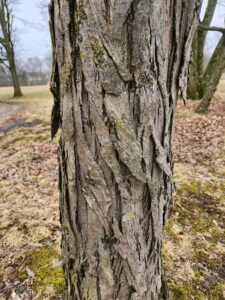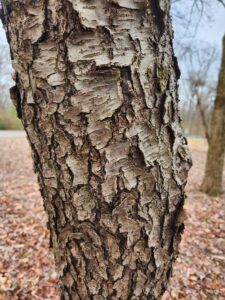By Edie Parnum
The aptly named shagbark hickory has loose bark. Black cherry’s bark has scales like burned potato chips. Other tree species have furrowed bark, too. All have crevices
where small insects and spiders, including their eggs and pupae live. Birds like Brown Creeper and White-breasted Nuthatch explore the trunks of trees to find their favorite foods.
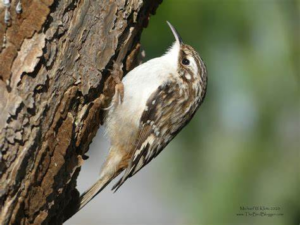
Brown Creeper searches for insects in bark. Photo by The Bird Blogger, Wikimedia Commons. Click to enlarge.
The Brown Creeper rarely visits bird feeders. Instead, this brown-streaked bird, camouflaged to blend into a tree trunk, feeds from bark. Starting at the bottom of thetrunk, the creeper climbs upward in a spiral, all the while examining the bark to find its tiny prey. Supported by a stiff tail held against the tree trunk, it probes with a thin, down-curved bill adapted to extract the nutritious morsels.
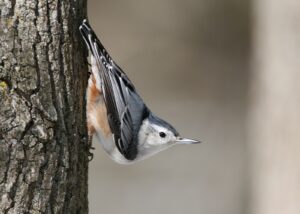
White-breasted nuthatch clings to tree trunks and branches probing for insects. Photo by Matt MacGillivray on Wikimedia Commons. Click to enlarge.
The White-breasted Nuthatch alsoscours tree bark for its food. This bird often faces downward, using a different perspective to find insects overlooked by the creeper and other birds. To keep from falling face-first, it has a backward facing toe with a strong, clasping claw. Its upturned bill is designed for extracting its prey from the bark. At feeders they will sometimes carry off seeds and nuts to store them in the crevices of bark for later consumption – hence the name “nuthatch”.
An entire guild of insects and birds rely on bark. Adult insects and spiders, together with their eggs, larvae, and pupa, are adapted to life on and in the bark. In addition to the Brown Creeper and White-breasted Nuthatch, woodpeckers, chickadees, and titmice also take advantage of this bounty.
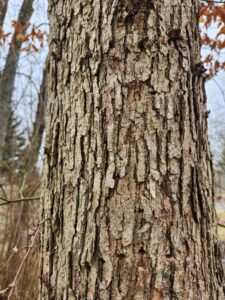
White oak. Bark of oaks hosts insects and their leaves host 557 caterpillar species. © Edie Parnum. Click to enlarge.
To host bark-loving insects, we should plant native trees such as oaks, birches, maples, hickories, pines, and cherries. Smaller native trees and shrubs like serviceberry, crabapple, dogwood, blueberries, and viburnums should be included, too. In just a few years these woody plants will develop bark where multiple insects will live. Of course, they will also produce leaves hosting the moth and butterfly caterpillars that birds, especially their young, require for their survival. These woody plants will develop additional life-giving foods like berries, buds, nuts, seeds, and nectar. As they grow, each year our native trees and shrubs will offer more biomass and hence foster greater ecological diversity.

